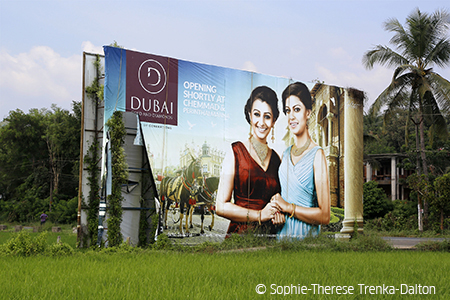Sophie-Therese Trenka-Dalton
bangaloREsident@Pepper House
Dubayyland – view from the other side:
During her stay in Kerala, visual artist Sophie-Therese Trenka-Dalton will continue her long-term project «Dubayyland», introducing a new chapter «Gulfi», focusing on the cultural and economic relations between Kerala and the UAE.

In her research-based installations, Trenka-Dalton examines the processes of cultural shifting and appropriation that occur when centres of power implode and reshape. She retraces the continuous migration of cultural motifs along objects, buildings and stories. For exhibitions, she develops architectural display-sculptures that present collected artifacts, sculptures, photography and video work. In addition, artist lectures give further insight into the chains of visual associations that run through her work.
During her stay in Kerala with the bangaloREsidency the artist will continue her long-term project Dubayyland (since 2009) and develop the new chapter Gulfi, which focuses on the cultural and economic relations between Kerala and the UAE. Starting point is the line of thought she developed for Dubayyland, where Dubai reads as a miniature and direct materialisation of the contemporary world and how it functions. Gulfi will examine Keralite life realities that have been influenced by migration specifically to the UAE and the resulting remittance capital returning to Kerala.
Sophie-Therese Trenka-Dalton has exhibited at basso, Berlin, Serpentine Gallery, London, Klaus von Nichtssagend Gallery, New York, Kunstraum Michael Barthel, Leipzig, Heidelberger Kunstverein, Heidelberg, KW Institute for Contemporary Art, Berlin, Alserkal Avenue, Dubai and Neuer Berliner Kunstverein, Berlin, amongst others. In 2016, her catalog PALMS was published by Textem Verlag Hamburg, giving a first comprehensive overview of projects and exhibitions since 2005. Also in 2016, she was voted onto the board of the berufsverband bildender künstler*innen (bbk berlin, Berlin’s main artist association), where she advocates for fair pay for artistic labour.



